Fiver-O
Active member
- Thread starter
- #1
Electric Tow Test! Ford F-150 Lightning vs. Rivian R1T
Which electric truck can go the farthest and charge the quickest?

So you’re curious about towing with an EV, but don’t want to risk it? We here at Edmunds are here to take the risk for you. We gathered our two long-term electric pickups that we bought and paid for and got busy. We hooked up our Ford F-150 Lightning and Rivian R1T to loaded box trailers and sent them on a mission. Which one performed the best and charged the quickest? Read on, friends.
Find your Ford F-150 Lightning
The trucks
Our 2022 Ford Lightning is equipped with the Blue Oval’s extended-range battery for 131 kWh of usable power. However, the pack also adds extra weight, decreasing this F-Series truck’s maximum towing capacity from 10,000 pounds to 7,700 pounds. The good news is that buyers can add a Max Trailer Tow Package, which increases cooling hardware, bumping that number back to as much as 10,000 pounds, depending on trim level. The Lightning comes with two electric motors good for 580 horsepower and 775 lb-ft of torque. Given all that power, it’s nice that it also comes with all-wheel drive.
Meanwhile, our long-term 2022 Rivian R1T comes with a 135-kWh battery and is capable of towing 11,000 pounds. The Rivian can be had with dual electric motors, but our tester is the fancy-pants quad motor, providing an Earth-turning 835 horses and 908 lb-ft of twist. As with the Ford, the power goes to all four wheels.

The route and planning
This is the same tow-test route we took when we evaluated a different Ford F-150 Lightning, Ram 1500 EcoDiesel, Chevrolet Silverado with a gas V8 and a Ford F-150 Hybrid a few months ago. It’s over 200 miles through the California desert with steep uphill sections that drain battery packs quickly, downhills that allow for plenty of regen, and a few flat sections that require a steady throttle. This route is often beset by sweltering temperatures, but our March testing made for pleasant weather at all elevations. We dutifully set our maximum speed to 55 miles per hour, not only for efficiency but also to follow California’s towing laws.
We have found this route to have a good number of public charging stations, including Level 3 DC fast chargers providing anywhere from 50 to 350 kW of charge. Unfortunately, we have also experienced inconsistent reliability from these outposts in trips past, an all-too-common issue with public charging stations these days. On our previous test, the Lightning only had to charge once while towing a Tesla Model 3 on a flatbed – a combination that weighed in at 6,975 pounds. This time, we intentionally swapped the open trailers for loads that were substantially less aerodynamic. Our plan was to charge in Bakersfield after 87 miles and then again in Mojave after 150 miles and the steep Tehachapi grade.
What did we tow?
Each truck hauled identical payloads: an all-electric Hyundai Ioniq 5 electric SUV in an enclosed trailer. Total weight was ballasted and equalized at 7,420 pounds by our crack test team. That’s pretty darn close to the Lightning’s 7,700-pound tow rating but far less than the 11,000 pounds the R1T is rated to drag.
Despite the Lightning being a full-size pickup and the Rivian being more of a midsize, the R1T actually weighs more – 7,069 pounds versus the Lightning’s 6,745 pounds. Adding it all up, the motors on both trucks would be tasked with hauling a total gross combined weight of just over 14,000 pounds. The Lightning sat pretty at a gross combined weight rating of 14,165 pounds, the R1T at 14,489 pounds.
However, the real kicker here is the 16-foot enclosed trailer. The floor sits 14 inches off the ground and the interior height is 6 feet, 6 inches, putting the trailer at 7 feet, 8 inches tall. The cab height of both the Lightning and R1T is just over six-and-a-half feet off the pavement. This means the trailer is over 1 foot higher than the trucks, making aerodynamics substantially worse.

Digging into the data
When we dive into the numbers, we can see the R1T charged the quickest. No surprise there, as it’s rated to receive a charge of 220 kW compared to the Lightning’s 150 kW. Keep in mind that those values are peak charge rates in ideal conditions. You won’t get those numbers for an entire charging session and you certainly won’t get them if the battery is close to full capacity, as the flow rate slows substantially as a pack’s capacity approaches 100%.
It’s worth taking a closer look at how much range these trucks can lose when towing. In ideal conditions and with a full battery, Ford’s unladen Lightning is rated to return as much as 320 miles of range and Rivian quotes the R1T at 314 miles. In our own testing on Edmunds’ EV range test loop, our long-term Lightning outperformed its factory rating. We saw 332 miles out of our truck, which has a specific trim rated at a slightly lower 300 miles. On the same test, we nabbed 317 miles in our R1T, slightly outpointing the automaker’s estimates.
When we hooked up our weighty Ioniq trailer to the Lightning, put it into tow mode — a process that included inputting our specific trailer’s weight and dimensions — the Ford’s indicated range immediately dropped to 150 miles.
By comparison, the Rivian asks far fewer questions. The R1T doesn’t prompt the driver for load weight or trailer dimensions, it only recognizes that it’s been put into tow mode. As such, our truck’s indicated range barely budged, initially only dropping to 300 miles.
However, all thoughts of the Rivian dragging its trailer 300 miles in one go was quickly quashed as we got underway. The R1T’s indicated range dropped quickly, essentially bringing it in line with the Lightning. As veteran EV drivers and load-towing experts, we anticipated this happening, but if you’re new to battery electric or load-lugging life, the Rivian’s plunging range could make for severe range anxiety or worse, a nasty, stranded-by-the-side-of-the-road surprise.
After 200-plus test miles, both trucks were surprisingly similar in their efficiency, with the Lightning averaging 1 mile of range per kWh and the R1T averaging a slightly worse 0.9 mile of range per kWh.
In the end, the biggest difference was in the way these two charged, and frankly, this was largely a matter of luck with a bit of poor time management thrown in. Over our two charging stops plus a final power-up back to 100%, the Lightning was hooked up to chargers for a total of 3 hours and 9 minutes and the R1T for 3 hours and 21 minutes.

But the Rivian is rated to accept a faster charge, so its overall charging time should’ve been less. What happened?
The Lightning’s average charging speed at our first stop was 118 kW over 22 minutes, but the R1T averaged a paltry 79 kW. This is because we kept the R1T plugged in for 57 minutes. As the truck approached 100% full, the charge rate slowed. Sure, the Rivian’s pack reached a 97% charge as opposed to the Ford’s 83%, but a second stop was inevitable, so we didn’t bother.
This scenario provides a good lesson in public charging. It’s rarely worth the time it takes to fill a pack to 100%. The amount of time you spend charging that last 20% takes way longer than the time it takes to expend the same amount of energy. In other words, you’ll maximize your efficiency if you keep your pack capped at an 80% to 85% state of charge. As an added bonus, this will also help prolong the life of your battery and keep charging bays open for other motorists.
It’s interesting to note just how much efficiency the Ford lost when equipped with the larger box trailer. In our previous open-trailer test, the Lightning managed 1.5 miles of range per kWh, or 64.6 kWh/100 miles. With our heavier, boxier trailer this trip, our Ford lost one-third of its range compared to the earlier test. Aerodynamics play a particularly big part in an EV’s efficiency, and nowhere is that more apparent than when towing with one.

So which is the better electric truck for towing?
Both trucks performed similarly in terms of efficiency, and they were equally good at powering over our route’s steep grades — all that electric torque makes for confident acceleration and passing. Further, both trucks feature independent suspension all the way around, helping them ride more comfortably on longer trips than your typical body-on-frame pickup. Finally, we found that both trucks’ regenerative braking abilities were well matched to towing, increasing our drivers’ confidence and efficiency. This wasn’t necessarily a given, and we were particularly pleased to see how both trucks self-slowed in a predictable, controllable fashion while stocking away electrons.
The bad news is that with both trucks, you’ll likely have to unhitch your trailer in order to charge, which is something you don’t have to do with a conventional truck at a typical pull-through gas station. This means you’ll need to add a bit more time to your journey for all that coupling and uncoupling. It also means you’ll want to find a charger located in a large parking lot, a key fact that’s often unknown until you arrive. Our Edmunds team had preexisting knowledge of our charging stops’ layouts in Bakersfield and Mojave, but that won’t always be the case if you’re towing in unfamiliar areas. Fortunately, EV charging network providers are starting to build infrastructure that accommodates towing, but it’s very early days for such configurations.
Overall, the Ford has a number of significant towing advantages over the Rivian. First, it’s easier to predict your actual range thanks to the towing questions the Lightning asks. The truck uses the extra data and your GPS route plan to calculate a more accurate total range estimate. You can input the trailer’s length, the load weight and other key factors, something you can’t do with the Rivian. The Ford’s blind-spot warning system can also cover the length of the trailer and its larger mirrors are better suited for seeing around long trailers as well.
The Lightning can also be had with the ProTrailer Backup Assist, an option that takes the mystery out of backing up a trailer. Instead of using the steering wheel and thinking “backwards,” drivers can intuitively reverse their truck by using a small knob located on the dash. Want the trailer to move to the right? Just turn the dial to the right. By comparison, the R1T’s more basic backup camera has hitch guidance lines, but the resolution is inferior, making hooking up a bit more difficult.
On the plus side, the Rivian’s tidier dimensions improve maneuverability, which can pay particularly big dividends when towing in tight spaces. (If only it had larger mirrors to really leverage this advantage!) The truck’s height-adjustable air suspension helps ensure a relatively low center of gravity, and combined with its hefty curb weight, it doesn’t bob around under load like some traditional trucks its size can. That confidence is underlined by the R1T’s excellent tow rating – 11,000 pounds is several thousand more than the next most powerful midsize pickup.
It’s worth noting that the F-150 Lightning is much less costly than the R1T, which Rivian markets as more of a high-end outdoor-lifestyle truck. Our Lightning 4x4 SuperCrew Lariat Extended-Range trim is a 2022 model, but if you want to snag a comparable 2023, it starts around $79,000 including $1,895 for destination and $1,395 for the Tow Technology package. You can grab the Max Trailer Tow package and its extra cooling for another $1,000.
Currently, only the R1T Adventure trim is available from Rivian. If you add in the all-terrain tires and the more powerful quad-motor powertrain like our tester, you’ll be forking out about $93,000. Yowza. Even the least expensive dual-motor option will set you back nearly $85,000.
Frustratingly, both trucks are in short supply and subject to dealer markups and waitlists. Neither is particularly inexpensive, but if you’ve been out of the truck-buying market for a while, you may be shocked to learn how pricey well-equipped pickups have gotten. It’s very easy to option up most light-duty gas or diesel trucks well into the $70,000s and $80,000s — if not beyond.
Edmunds says
In the end, while towing with an EV has many benefits, at this time, we continue to recommend that those who trailer large loads regularly stick with a traditional gas or diesel truck, especially if your hauls cover significant distances. However, if you’re just in the towing game a few times a year and you want to go electric, we think the Ford F-150 Lightning is your best bet. We’ll soon see full-size electric pickups from Chevrolet, GMC, Ram and Tesla, so it’ll likely be time for another Edmunds all-electric tow-off before you know it. In the meantime, drivers should carefully research their planned charging stations to make sure there’s enough room to unhitch your trailer and always have a backup option at the ready.
Which electric truck can go the farthest and charge the quickest?
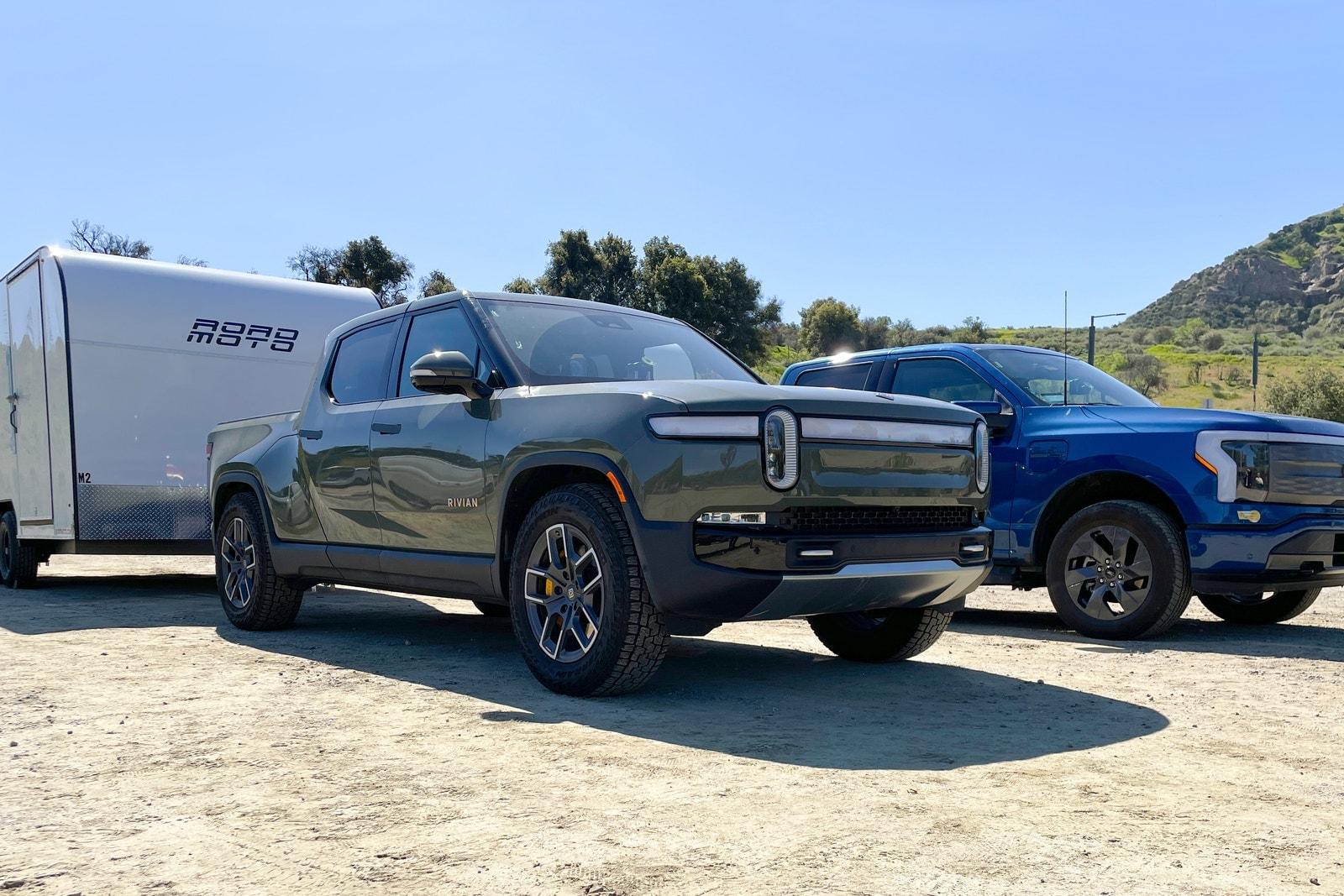
- We pit our Ford F-150 Lightning against a Rivian R1T in an all-electric tow test.
- We learn how trailer type can impact efficiency.
- The Rivian often indicates more range than it really has.
So you’re curious about towing with an EV, but don’t want to risk it? We here at Edmunds are here to take the risk for you. We gathered our two long-term electric pickups that we bought and paid for and got busy. We hooked up our Ford F-150 Lightning and Rivian R1T to loaded box trailers and sent them on a mission. Which one performed the best and charged the quickest? Read on, friends.
Find your Ford F-150 Lightning
The trucks
Our 2022 Ford Lightning is equipped with the Blue Oval’s extended-range battery for 131 kWh of usable power. However, the pack also adds extra weight, decreasing this F-Series truck’s maximum towing capacity from 10,000 pounds to 7,700 pounds. The good news is that buyers can add a Max Trailer Tow Package, which increases cooling hardware, bumping that number back to as much as 10,000 pounds, depending on trim level. The Lightning comes with two electric motors good for 580 horsepower and 775 lb-ft of torque. Given all that power, it’s nice that it also comes with all-wheel drive.
Meanwhile, our long-term 2022 Rivian R1T comes with a 135-kWh battery and is capable of towing 11,000 pounds. The Rivian can be had with dual electric motors, but our tester is the fancy-pants quad motor, providing an Earth-turning 835 horses and 908 lb-ft of twist. As with the Ford, the power goes to all four wheels.
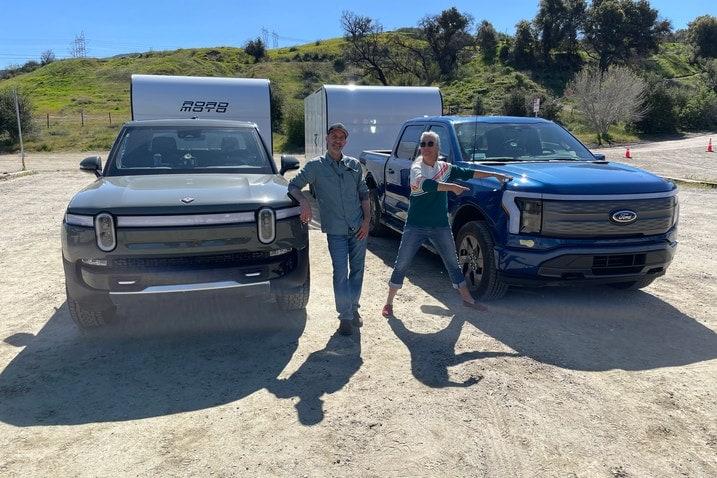
The route and planning
This is the same tow-test route we took when we evaluated a different Ford F-150 Lightning, Ram 1500 EcoDiesel, Chevrolet Silverado with a gas V8 and a Ford F-150 Hybrid a few months ago. It’s over 200 miles through the California desert with steep uphill sections that drain battery packs quickly, downhills that allow for plenty of regen, and a few flat sections that require a steady throttle. This route is often beset by sweltering temperatures, but our March testing made for pleasant weather at all elevations. We dutifully set our maximum speed to 55 miles per hour, not only for efficiency but also to follow California’s towing laws.
We have found this route to have a good number of public charging stations, including Level 3 DC fast chargers providing anywhere from 50 to 350 kW of charge. Unfortunately, we have also experienced inconsistent reliability from these outposts in trips past, an all-too-common issue with public charging stations these days. On our previous test, the Lightning only had to charge once while towing a Tesla Model 3 on a flatbed – a combination that weighed in at 6,975 pounds. This time, we intentionally swapped the open trailers for loads that were substantially less aerodynamic. Our plan was to charge in Bakersfield after 87 miles and then again in Mojave after 150 miles and the steep Tehachapi grade.
What did we tow?
Each truck hauled identical payloads: an all-electric Hyundai Ioniq 5 electric SUV in an enclosed trailer. Total weight was ballasted and equalized at 7,420 pounds by our crack test team. That’s pretty darn close to the Lightning’s 7,700-pound tow rating but far less than the 11,000 pounds the R1T is rated to drag.
Despite the Lightning being a full-size pickup and the Rivian being more of a midsize, the R1T actually weighs more – 7,069 pounds versus the Lightning’s 6,745 pounds. Adding it all up, the motors on both trucks would be tasked with hauling a total gross combined weight of just over 14,000 pounds. The Lightning sat pretty at a gross combined weight rating of 14,165 pounds, the R1T at 14,489 pounds.
However, the real kicker here is the 16-foot enclosed trailer. The floor sits 14 inches off the ground and the interior height is 6 feet, 6 inches, putting the trailer at 7 feet, 8 inches tall. The cab height of both the Lightning and R1T is just over six-and-a-half feet off the pavement. This means the trailer is over 1 foot higher than the trucks, making aerodynamics substantially worse.
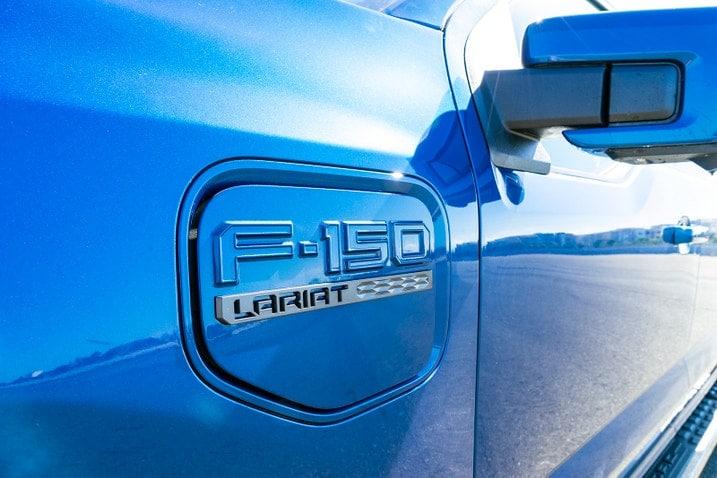
Digging into the data
When we dive into the numbers, we can see the R1T charged the quickest. No surprise there, as it’s rated to receive a charge of 220 kW compared to the Lightning’s 150 kW. Keep in mind that those values are peak charge rates in ideal conditions. You won’t get those numbers for an entire charging session and you certainly won’t get them if the battery is close to full capacity, as the flow rate slows substantially as a pack’s capacity approaches 100%.
It’s worth taking a closer look at how much range these trucks can lose when towing. In ideal conditions and with a full battery, Ford’s unladen Lightning is rated to return as much as 320 miles of range and Rivian quotes the R1T at 314 miles. In our own testing on Edmunds’ EV range test loop, our long-term Lightning outperformed its factory rating. We saw 332 miles out of our truck, which has a specific trim rated at a slightly lower 300 miles. On the same test, we nabbed 317 miles in our R1T, slightly outpointing the automaker’s estimates.
When we hooked up our weighty Ioniq trailer to the Lightning, put it into tow mode — a process that included inputting our specific trailer’s weight and dimensions — the Ford’s indicated range immediately dropped to 150 miles.
By comparison, the Rivian asks far fewer questions. The R1T doesn’t prompt the driver for load weight or trailer dimensions, it only recognizes that it’s been put into tow mode. As such, our truck’s indicated range barely budged, initially only dropping to 300 miles.
However, all thoughts of the Rivian dragging its trailer 300 miles in one go was quickly quashed as we got underway. The R1T’s indicated range dropped quickly, essentially bringing it in line with the Lightning. As veteran EV drivers and load-towing experts, we anticipated this happening, but if you’re new to battery electric or load-lugging life, the Rivian’s plunging range could make for severe range anxiety or worse, a nasty, stranded-by-the-side-of-the-road surprise.
After 200-plus test miles, both trucks were surprisingly similar in their efficiency, with the Lightning averaging 1 mile of range per kWh and the R1T averaging a slightly worse 0.9 mile of range per kWh.
In the end, the biggest difference was in the way these two charged, and frankly, this was largely a matter of luck with a bit of poor time management thrown in. Over our two charging stops plus a final power-up back to 100%, the Lightning was hooked up to chargers for a total of 3 hours and 9 minutes and the R1T for 3 hours and 21 minutes.
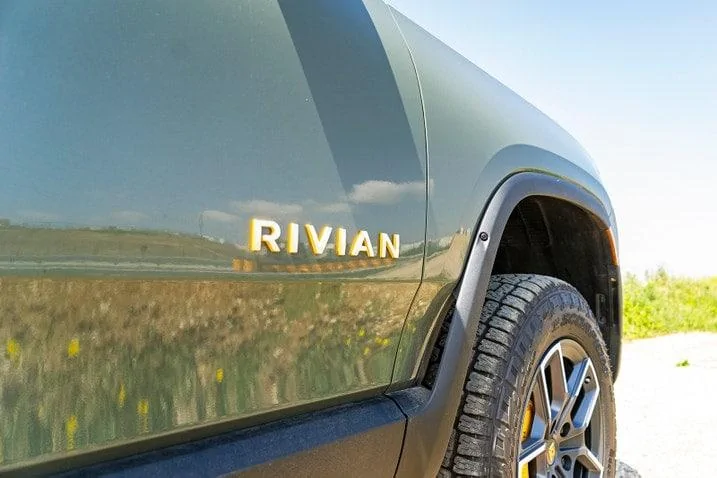
But the Rivian is rated to accept a faster charge, so its overall charging time should’ve been less. What happened?
The Lightning’s average charging speed at our first stop was 118 kW over 22 minutes, but the R1T averaged a paltry 79 kW. This is because we kept the R1T plugged in for 57 minutes. As the truck approached 100% full, the charge rate slowed. Sure, the Rivian’s pack reached a 97% charge as opposed to the Ford’s 83%, but a second stop was inevitable, so we didn’t bother.
This scenario provides a good lesson in public charging. It’s rarely worth the time it takes to fill a pack to 100%. The amount of time you spend charging that last 20% takes way longer than the time it takes to expend the same amount of energy. In other words, you’ll maximize your efficiency if you keep your pack capped at an 80% to 85% state of charge. As an added bonus, this will also help prolong the life of your battery and keep charging bays open for other motorists.
It’s interesting to note just how much efficiency the Ford lost when equipped with the larger box trailer. In our previous open-trailer test, the Lightning managed 1.5 miles of range per kWh, or 64.6 kWh/100 miles. With our heavier, boxier trailer this trip, our Ford lost one-third of its range compared to the earlier test. Aerodynamics play a particularly big part in an EV’s efficiency, and nowhere is that more apparent than when towing with one.
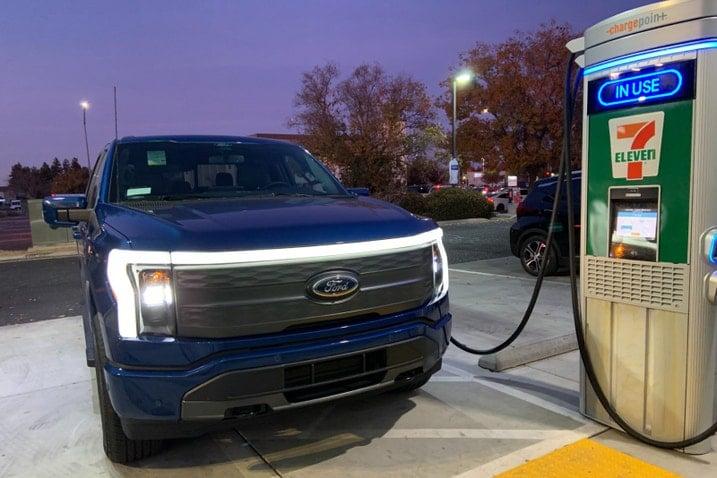
So which is the better electric truck for towing?
Both trucks performed similarly in terms of efficiency, and they were equally good at powering over our route’s steep grades — all that electric torque makes for confident acceleration and passing. Further, both trucks feature independent suspension all the way around, helping them ride more comfortably on longer trips than your typical body-on-frame pickup. Finally, we found that both trucks’ regenerative braking abilities were well matched to towing, increasing our drivers’ confidence and efficiency. This wasn’t necessarily a given, and we were particularly pleased to see how both trucks self-slowed in a predictable, controllable fashion while stocking away electrons.
The bad news is that with both trucks, you’ll likely have to unhitch your trailer in order to charge, which is something you don’t have to do with a conventional truck at a typical pull-through gas station. This means you’ll need to add a bit more time to your journey for all that coupling and uncoupling. It also means you’ll want to find a charger located in a large parking lot, a key fact that’s often unknown until you arrive. Our Edmunds team had preexisting knowledge of our charging stops’ layouts in Bakersfield and Mojave, but that won’t always be the case if you’re towing in unfamiliar areas. Fortunately, EV charging network providers are starting to build infrastructure that accommodates towing, but it’s very early days for such configurations.
Overall, the Ford has a number of significant towing advantages over the Rivian. First, it’s easier to predict your actual range thanks to the towing questions the Lightning asks. The truck uses the extra data and your GPS route plan to calculate a more accurate total range estimate. You can input the trailer’s length, the load weight and other key factors, something you can’t do with the Rivian. The Ford’s blind-spot warning system can also cover the length of the trailer and its larger mirrors are better suited for seeing around long trailers as well.
The Lightning can also be had with the ProTrailer Backup Assist, an option that takes the mystery out of backing up a trailer. Instead of using the steering wheel and thinking “backwards,” drivers can intuitively reverse their truck by using a small knob located on the dash. Want the trailer to move to the right? Just turn the dial to the right. By comparison, the R1T’s more basic backup camera has hitch guidance lines, but the resolution is inferior, making hooking up a bit more difficult.
On the plus side, the Rivian’s tidier dimensions improve maneuverability, which can pay particularly big dividends when towing in tight spaces. (If only it had larger mirrors to really leverage this advantage!) The truck’s height-adjustable air suspension helps ensure a relatively low center of gravity, and combined with its hefty curb weight, it doesn’t bob around under load like some traditional trucks its size can. That confidence is underlined by the R1T’s excellent tow rating – 11,000 pounds is several thousand more than the next most powerful midsize pickup.
It’s worth noting that the F-150 Lightning is much less costly than the R1T, which Rivian markets as more of a high-end outdoor-lifestyle truck. Our Lightning 4x4 SuperCrew Lariat Extended-Range trim is a 2022 model, but if you want to snag a comparable 2023, it starts around $79,000 including $1,895 for destination and $1,395 for the Tow Technology package. You can grab the Max Trailer Tow package and its extra cooling for another $1,000.
Currently, only the R1T Adventure trim is available from Rivian. If you add in the all-terrain tires and the more powerful quad-motor powertrain like our tester, you’ll be forking out about $93,000. Yowza. Even the least expensive dual-motor option will set you back nearly $85,000.
Frustratingly, both trucks are in short supply and subject to dealer markups and waitlists. Neither is particularly inexpensive, but if you’ve been out of the truck-buying market for a while, you may be shocked to learn how pricey well-equipped pickups have gotten. It’s very easy to option up most light-duty gas or diesel trucks well into the $70,000s and $80,000s — if not beyond.
Edmunds says
In the end, while towing with an EV has many benefits, at this time, we continue to recommend that those who trailer large loads regularly stick with a traditional gas or diesel truck, especially if your hauls cover significant distances. However, if you’re just in the towing game a few times a year and you want to go electric, we think the Ford F-150 Lightning is your best bet. We’ll soon see full-size electric pickups from Chevrolet, GMC, Ram and Tesla, so it’ll likely be time for another Edmunds all-electric tow-off before you know it. In the meantime, drivers should carefully research their planned charging stations to make sure there’s enough room to unhitch your trailer and always have a backup option at the ready.
Sponsored

